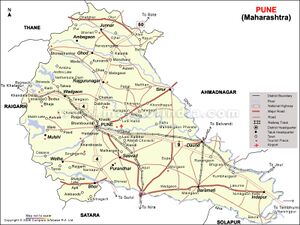Bhaja
| Author:Laxman Burdak, IFS (R) |
Bhaja (भाजा) is a village in Pune district of Maharashtra. It is located on Pune-Mumbai Railway line. It is known for Bhaja Caves, a group of 22[1] rock-cut caves dating back to the 2nd century BC located 400 feet above the village of Bhaja, near Lonavala, Maharashtra.
Variants
- Bhaja (भाजा), महा., (AS, p.664)
- Isapuri (ईसापुरी) = Bhaja (भाजा) (AS, p.85)
- Ishapuri (ईशापुरी) (AS, p.664)
- Bhaja Caves
Origin
History
The caves are 400 feet above the village of Bhaja,[2] on an important ancient trade route running from the Arabian Sea eastward into the Deccan Plateau (the division between North India and South India).[3] The inscriptions and the cave temple are protected as a Monument of National Importance, by the Archaeological Survey of India per Notification No. 2407-A. It belongs to the Hinayana Buddhism sect in Maharashtra.[4] The caves have a number of stupas, one of their significant features. The most prominent excavation is its chaitya (or chaityagrha - Cave XII), a good example of the early development of this form from wooden architecture, with a vaulted horseshoe ceiling. Its vihara (Cave XVIII) has a pillared verandah in front and is adorned with unique reliefs.[5] These caves are notable for their indications of the awareness of wooden architecture.[6] The carvings prove that tabla – a percussion instrument – was used in India for at least two thousand years. The carving shows a woman playing tabla and another woman, performing dance.
The Bhaja Caves share architectural design with the Karla Caves. The most impressive monument is the large shrine — chaityagriha — with an open, horseshoe-arched entrance; according to the Archaeological Survey of India, the chaityagrha is the most prominent aspect of the caves, and one of the earliest of the type.[2] The chaitrya has unique reliefs from Indian mythology. Other caves have a nave and aisle, with an apse containing a solid tupa and the aisle circling round the apse, providing the circumambulation path.[7]
Chaitygraha has some Buddha images. A cistern inscription shows the name of a donor, Maharathi Kosikiputa Vihnudata, from the 2nd century AD. A wooden beam records two more inscriptions datable to the 2nd century B.C., which indicates caves have been there for at least 2200 years.[8] Eight inscriptions are found in the caves, some giving the name of the donors.[9]
The sculptures feature elaborate headdress, garlands, and jewellery; they might have originally been painted in bright colors but later covered with plaster. Characteristic for early Buddhism, initially the caves had symbolic Buddha representation. After 4 A.D. Buddha was painted in physical form as well.[10]
भाजा
विजयेन्द्र कुमार माथुर[11] ने लेख किया है ...भाजा (AS, p.664) भारत के महाराष्ट्र में मुम्बई पूना रेलमार्ग पर मलवाणी स्टेशन के निकट स्थित है। इसका निर्माण द्वितीय शताब्दी ई.पू. में किया गया था। यह बौद्धकालीन गुफ़ाओं के लिए प्रसिद्ध है। भाजा चैत्य गृह को इस क्षेत्र का प्राचीनतम उदाहरण माना जाता है। इसके भीतर स्थापित ठोस स्तूप अत्यंत सादा है। गुफ़ाओं में मूर्ति कला के नमूने अल्प हैं। भाजा में 22 गुफ़ाएँ हैं, इनमें चैत्य गृह, विहार और ठोस स्तूप सम्मिलित हैं। भाजा का चैत्य गृह आंरभिक काल का है, जिसका निर्माणकाल 200-300 ई.पू. निर्धारित किया गया है। यहाँ का चैत्य गृह इस क्षेत्र का सबसे प्राचीन चैत्य है। क्षेत्रफल के हिसाब से यह 38.25 मीटर लम्बा, 15 मीटर चौड़ा और 14,50 मीटर ऊँचा है। भाजा में एक आयताकार कमरा 18 मीटर लम्बा 8,50 मीटर चौड़ा व 6,5 मीटर ऊँचा है। इसके सामने बरामदा और आठ प्रकोष्ठ हैं, जो भिक्षुओं के रहने के काम आते थे। इस चैत्य का गवाक्ष गोलाकार है, पाषाण खम्भे थोड़े तिरछे हैं तथा स्तूप में किसी प्रकार के अलंकरण की जानकारी नहीं मिलती। इनकी भित्तियों पर पाँच मानव आकृतियाँ उत्कीर्ण हैं, जिनके नीचे दानवों की प्रतिमाएँ हैं। यहाँ दूसरी मूर्ति गजारूढ़ देवेन्द्र की है। यह गुहा-विहार सूर्य उपासकों द्वारा निर्मित जान पड़ता है।
भाजा की पहाड़ी पर लोहगढ़ तथा ईशापुरी के प्राचीन दुर्ग हैं.
External links
References
- ↑ "Ticketed Monuments - Maharashtra Bhaja Caves, Bhaja". Archaeological Survey of India, Government of India.
- ↑ "CHAPTER 20 PLACES OF INTEREST". Maharashtra Government - Tourism and Cultural Dept.
- ↑ "Later Andhra Period India".
- ↑ "Ticketed Monuments - Maharashtra Bhaja Caves, Bhaja". Archaeological Survey of India, Government of India.
- ↑ Ahir, D. C. (2003). Buddhist sites and shrines in India: history, art, and architecture (1. ed.). Delhi: Sri Satguru Publ. p. 191. ISBN 8170307740.
- ↑ "Ticketed Monuments - Maharashtra Bhaja Caves, Bhaja". Archaeological Survey of India, Government of India.
- ↑ "5000 Years of Indian Architecture". Archived
- ↑ "Ticketed Monuments - Maharashtra Bhaja Caves, Bhaja". Archaeological Survey of India, Government of India.
- ↑ Ahir, D. C. (2003). Buddhist sites and shrines in India: history, art, and architecture (1. ed.). Delhi: Sri Satguru Publ. p. 191. ISBN 8170307740.
- ↑ Behl, Benoy K (September 22, 2007). "Grandeur in caves". Frontline. 24 (19).
- ↑ Aitihasik Sthanavali by Vijayendra Kumar Mathur, p.664
